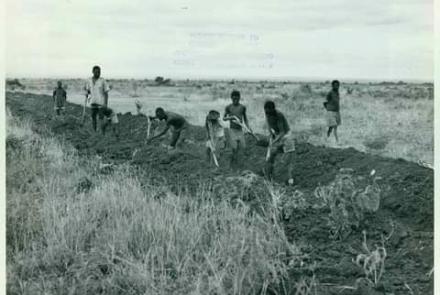Education at the Mission School at Thogoto
In November 1909, Kenyatta under his tribal name of Kamau wa Ngengi went to Thogoto and enrolled in the missionary school. He started life at Thogoto by washing dishes, learning to sew and weeding the gardens. Kenyatta came into contact with Arthur Ruffell Barlow (the nephew by marriage of Clement Ruffell Scott) who joined the mission at Christmas 1905, after two years at a nearby farm. Barlow joined in Kikuyu dances and was among the first Europeans to learn the Kikuyu language. He later made available the New Testament by translating St Mark’s Gospel into Kikuyu.
Five years older than Barlow was John W Arthur who arrived at Thogoto in January 1907 as the new mission doctor. Within a few months of his arrival, Kenyatta fell ill with phthisis, a lung infection common among the thinly-clad Kikuyu herd boys. Kenyatta was moved to the Hunter Memorial Hospital, named after the benefactor of the mission and opened in January 1908. He was released after a month’s treatment. After this, Arthur gave his name in the mission journal and so in this way from early in his life, Kenyatta received spiritual support from Christians from across the seas.
But when the Europeans offered to teach the children of the Kikuyu, they met constant opposition. Parents were unwilling to see their children abandon their traditional tasks around the ‘shambas’. As a result, the school at Thogoto was slow to get enough enrolments. But by the end of 1909, the situation was slowly improving with the institution of a boarding house for sixteen boys and of an industrial scheme for a further fourteen, supported by government grants.
In their teaching, Missionaries had to begin at the most basic level. In the elementary classes, their objective was to enable the boys to read Kikuyu versions of the Old Testament stories. It was not until later that they were able to move on to Barlow’s new translation of St Mark’s Gospel.
A year after his arrival, Kenyatta was sponsored by the Sunday school of St John’s Church, Dundee, and for the next four years they supported him both spiritually and financially. However, his progress through the elementary grades was unremarkable and in July 1912, after completing this primary schooling, he chose to be apprenticed as a carpenter.
In 1912, Kenyatta, with seven other boys and seven girls, all dressed in white robes, made his vows at a solemn and moving service in the small church at Thogoto. It committed him, according to Arthur, to spend the next two years as a catechumen both undergoing instruction every Sunday morning until ready for baptism, and by giving up tribal life.
But despite his commitment to the Church, Kenyatta also underwent the traditional Kikuyu initiation ceremony for boys to mark their entry into the ranks of the warriors. It also symbolized in a real psychological sense a rebirth into the full life of the community. The missionaries recognized the significance of the initiatory rites but they considered the physical operation of circumcision to be brutal and unhygienic and, in the case of girls, barbaric mutilation that caused permanent injury. Equally, the atmosphere in which the ceremonies were carried out seemed to the missionaries especially evil. Hence they criticized the practices and prayed that the people might forgo them altogether. At the time, it was unthinkable for a Kikuyu boy or girl not to be circumcised. The only circumstance under which circumcision was permitted was when undertaken at the mission hospital, and under proper medical procedures. Others stole away when their time came and took their place in the village group
Kenyatta was no different and in 1913, presumably at the normal time of year, February, when the mission school was on holiday, a compromise was made by the missionary teacher, Garrioch, who collected a small group eligible for initiation, down to Nyongara stream. They each had a sponsor or circumcision father who stood behind them during the ceremony and acted as guardian on behalf of the tribe. Samson Njoroge, the first Kikuyu to train as a hospital assistant, performed the operation. Kenyatta had asked Musa Gitau to act as his sponsor and it was to Musa’s hut that he now came as to the home of a new “father”. He was now born again into full membership of the tribe, a grade called ‘Mubengi,’.
Baptism was also a form of initiation for the young men who came forward. It was considered the hallmark of a mission education. It gave to them a credential of responsibility on which depended not only their spiritual life but also their job prospects. The custom at Thogoto was that the boy to be baptized had to choose a Christian name which they would thereafter be known by. Kenyatta chose John and Peter, but the missionaries would only allow one name. He therefore changed Peter into its Hebraic equivalent, ‘Stone’, and attached this to John, so was baptized as Johnstone, thus satisfying the Mission requirements. In 1914 he was baptized Johnstone Kamau.
After his baptism, Kenyatta left the dormitory and lived for a time with friends near the mission. He had shown little promise with either his studies or his trade as a carpenter. The mission therefore asked him to sign on for a further term of apprenticeship, but as a mason. Masons were thought of as being lower category of workers than carpenters and so he refused. Now Thogoto had little more to offer him and he turned, as did many of his generation, to the city, Nairobi, only a few miles.


